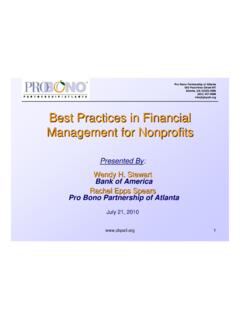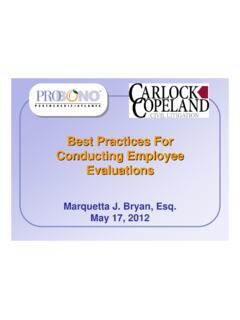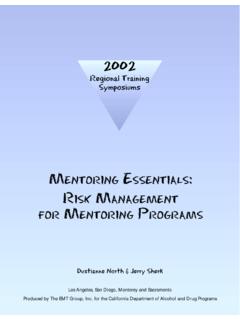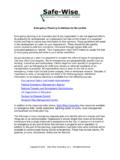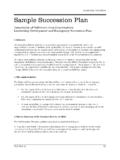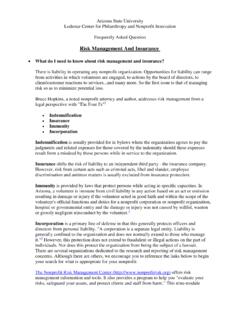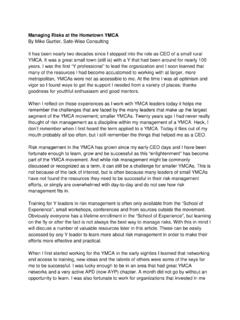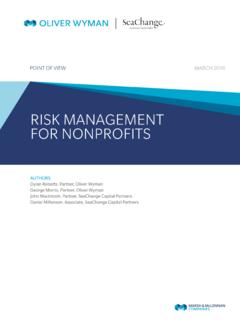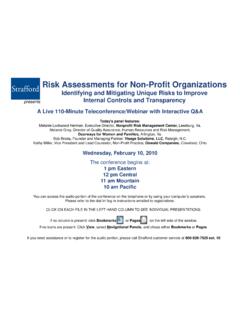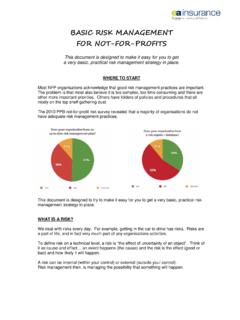Transcription of A NONPROFIT S GUIDE TO RISK MANAGEMENT
1 A NONPROFIT S GUIDE TO RISK MANAGEMENT & INSURANCE 2 TABLE OF CONTENTS PAGE RISK 3 I. 3 II. Case 3 ASSESSING 4 I. Business 5 MITIGATING 6 I. Categories of 6 II. Safety 8 III. Train 8 IV. Follow Best 8 V. Set the Right 9 VI. Put It in 9 VII. Risk MANAGEMENT and 9 VIII. Waivers of 10 IX. Charitable 10 X. 11 INSURING AGAINST 14 I. The 14 II. Types of 15 III. Insurance Policies Most Important for a NONPROFIT 16 A. General 16 B. Directors and Officers Insurance (D&O).. 16 C. Workers 17 D. Property 17 E. Volunteer Accidental Medical 18 F. Automobile 18 IV.
2 Terms of 19 A. Declarations 19 B. 19 C. Insuring 19 D. 19 E. 19 F. 20 V. Limits on 20 A. Umbrella 20 VI. How Much You Should Spend on 21 VII. Other Insurance 22 A. Additional 22 B. Duty to 22 C. Claims Made Versus Claims 22 D. 23 VIII. Serious Losses and Filing a 23 IX. Obtaining and Retaining Copies of Your 24 X. 24 ADDITIONAL 26 3 Risk MANAGEMENT It is an experience common to all men to find that, on any special occasion, .. everything that can go wrong will go wrong. Whether we must attribute this to the malignity of matter or to the total depravity of inanimate things, whether the exciting cause is hurry, worry, or what not, the fact remains.
3 Nevil Maskelyne I. Introduction Risk MANAGEMENT does not represent the most exciting or inspiring part of a NONPROFIT organization s work. However, it is as crucial as any other task a NONPROFIT undertakes, because good risk MANAGEMENT ensures that the NONPROFIT will have enough assets to carry out its mission. It also ensures that the NONPROFIT s actions will not harm the client population it is trying to serve, the general public, or the organization s employees and volunteers. NONPROFIT organizations without a risk MANAGEMENT plan leave themselves vulnerable to events that could impose staggering costs or entirely shut down their operations.
4 As unpleasant as it is, bad things, such as accidents, happen every day. No organization is immune from the possibility that its plan of action even a well-thought-out one could go seriously wrong. Risk MANAGEMENT is the process by which an organization reviews its susceptibility to unexpected losses and develops strategies both to prevent them from happening and to reduce the expense when they do. Every NONPROFIT organization needs to create a risk MANAGEMENT plan and review it annually. The organization should also review it after it makes a significant change to the types of activities it engages in or when it acquires a piece of property, a new computer system, or other significant acquisition.
5 For nonprofits with more limited funding, the responsibility for creating a risk MANAGEMENT plan falls on the NONPROFIT s board of directors and MANAGEMENT . This manual will walk you through the risk MANAGEMENT process. It will explain the three fundamental steps that an organization should take in order to create a risk MANAGEMENT plan : 1. Assess the NONPROFIT s risks ; 2. Mitigate those risks to the greatest extent practicable; and 3. Obtain insurance to help pay the costs in the event a loss occurs. II. Case Study Throughout this booklet, we will follow the case of the Happy Child After-School Program as it tries to develop a risk MANAGEMENT program.
6 Happy Child is a NONPROFIT incorporated in the District of Columbia and is exempt from tax under section 501(c)(3) of the Internal Revenue Code. It has been in operation for 14 years. It owns the building in which it operates and two 15-passenger vans to transport children. Its annual budget is $ million, of which 40 percent comes from government grants. Happy Child s mission is to provide childcare services for parents in the District s Anacostia neighborhood. In its service area, 33 percent of the children live in poverty and the unemployment rate has averaged 25 percent over the past several years. 4 Quality, affordable childcare services are critical in order to allow parents to work.
7 In addition, the Happy Child program provides after-school tutoring, creative arts enrichment, and computer skills training for its students, many of whom are at high risk of not graduating from high school. Happy Child serves 110 children ages five through 15. It operates from the end of the school day through 6 on weekdays, and all day during school breaks. During the program day, Happy Child supervises the children as they participate in the various activities and provides them with an afternoon snack or meals, as appropriate. It has 27 full-time and part-time employees and a nine-member board of directors.
8 It also has 30 regular volunteers and approximately 50 occasional volunteers. The regular volunteers work one-on-one with children in need of tutors and teach classes in computer skills, art, dance, and drama. There are also volunteers who help coach sports. Assessing Risk The basic task of risk assessment is to imagine all the actions and relationships of a NONPROFIT organization that possibly could go wrong. Think of what would constitute a Really Bad Day. Begin by considering all of the actions that your organization must perform in order to carry out its mission. Within all of your organization s actions, there exists the possibility that an unplanned event or error may occur that could put your resources and assets in jeopardy.
9 Liability can take many forms. The most common form of potential liability is tort liability. Under the law, a NONPROFIT organization may be liable for a tort if it fails in its duty of care to others, and someone is injured as a result. This category generally includes preventable accidents, which may include slips and falls and car wrecks. In addition to bodily injuries, types of injury that may trigger tort claims include property damage and certain types of business injury, like slander and libel. Now let us look at what risks Happy Child faces. The executive director, Betty Johnson, has started to develop a list of some of the risks that Happy Child faces during a typical day of operations.
10 Here is her list: What would a bad day look like? 1. Children get hurt playing because of: a. Unsafe equipment b. Failure to supervise. 2. Children get sick from poor sanitation practices in the kitchen. 3. A volunteer sexually molests a child. 4. A teacher or volunteer improperly disciplines a child. 5. Children are exposed to pornography while playing on the computer. 6. An employee suspects that a child is a victim of child abuse and fails to report the abuse as required by law. 5 7. There is a fire and there is an injury to children and staff due to lack of: a. Safety equipment b. Staff training c. Fire inspections. While such a list may seem daunting, it is important to remember that there are many things an organization already does as part of its normal operation to decrease the risk of injury.
